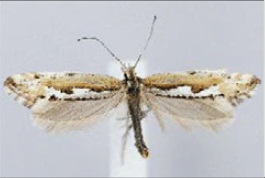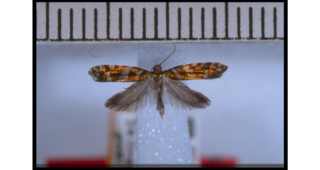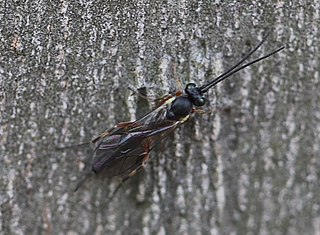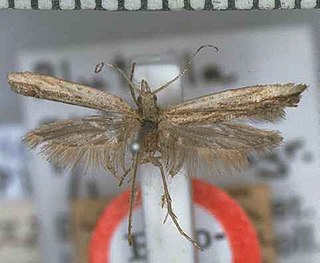The term cabbage worm is primarily used for any of four kinds of lepidopteran larvae that feed on cabbages and other cole crops. Favorite foods include broccoli, cauliflower, Brussels sprouts, collards, kale, mustard greens, turnip greens, radishes, turnips, rutabagas and kohlrabi. This small group of similar pest species is known to agriculturists as the cabbage worm compte butterflies.

Barbarea vulgaris, also called wintercress, or alternatively winter rocket, rocketcress, yellow rocketcress, yellow rocket, wound rocket, herb barbara, creases, or creasy greens, is a biennial herb of the genus Barbarea, belonging to the family Brassicaceae.

The diamondback moth, sometimes called the cabbage moth, is a moth species of the family Plutellidae and genus Plutella. The small, grayish-brown moth sometimes has a cream-colored band that forms a diamond along its back. The species may have originated in Europe, South Africa, or the Mediterranean region, but it has now spread worldwide.

The Plutellidae are a family of moths commonly known as the diamondback moths, named after the diamondback moth of European origin. It was once considered to have three subfamilies: Plutellinae, Praydinae, and Scythropiinae. Praydinae was later elevated to its own family, Praydidae, while Scythropiinae has variously been moved to Yponomeutidae or also elevated to its own family.

The leek moth or onion leaf miner is a species of moth of family Acrolepiidae and the genus Acrolepiopsis. The species is native to Europe and Siberia, but is also found in North America, where it is an invasive species. While it was initially recorded in Hawaii, this was actually a misidentification of Acrolepiopsis sapporensis.

Leuroperna sera is a moth of the family Plutellidae first described by Edward Meyrick in 1885. It is found in Japan, Taiwan, Vietnam, Indonesia, India, Sri Lanka, Australia, and New Zealand.

Plutella porrectella is a moth of the family Plutellidae found in Europe, the Caucasus, southern Siberia and Asia Minor.
Streptanthus polygaloides is a species of flowering plant in the mustard family known by the common name milkwort jewelflower. It is endemic to the Sierra Nevada foothills of California, where it grows in woodlands and chaparral, generally on serpentine soils.

Hair-pencils and coremata are pheromone signaling structures present in lepidopteran males. Males use hair-pencils in courtship behaviors with females. The pheromones they excrete serve as both aphrodisiacs and tranquilizers to females as well as repellents to conspecific males. Hair-pencil glands are stored inside the male until courtship begins, at which point they are forced out of the body by sclerotized levers present on the abdomen. Coremata are very similar structures. Their exact definition is confused by early descriptions but they are more specifically defined as the internal, glandular, eversible structures that bear the hair-pencils and can be voluntarily inflated with hemolymph or air.
Diadegma mollipla is a wasp which parasitises the larvae of the diamondback moth and the potato tuber moth. The species was first described by August Holmgren in 1868. Its range includes the Canary Islands, Britain and parts of Africa.

Plutella armoraciae is a moth of the family Plutellidae. It is found in north-western North America.

Plutella hyperboreella is a moth of the family Plutellidae. It is found in Finland, Norway, Sweden, arctic Russia and Canada.
Eidophasia dammersi is a moth of the family Plutellidae. It is found in California and Arizona in the United States.

Plutella is a genus of moths in the family Plutellidae.

Chrysorthenches argentea is a species of moth in the family Plutellidae. It was described by John S. Dugdale in 1996. It is endemic to New Zealand and has been observed in the Buller District and in the West Coast. The larval host is Manoao colensoi. Adults are on the wing in December.
Plutella polaris is a moth species in the family Plutellidae and was first described by Philipp Christoph Zeller in 1880. It is known to occur in Svalbard, Norway, and the Altai Mountains of Russia.

Diadegma semiclausum is a species of parasitic wasp in the family Ichneumonidae. Its larvae are parasites of the larvae of the diamondback moth and certain other moths.

Chrysorthenches phyllocladi is a species of moth in the family Plutellidae. It was first described by John S. Dugdale in 1996. It is endemic to New Zealand and has been observed in both the North and South Islands. The larvae of this species feed on Phyllocladus alpinus. Adults have been observed on the wing in February, April and November.

Plutella antiphona, also known as the diamondback moth, is a moth of the family Plutellidae first described by Edward Meyrick in 1901. It is endemic to New Zealand.













